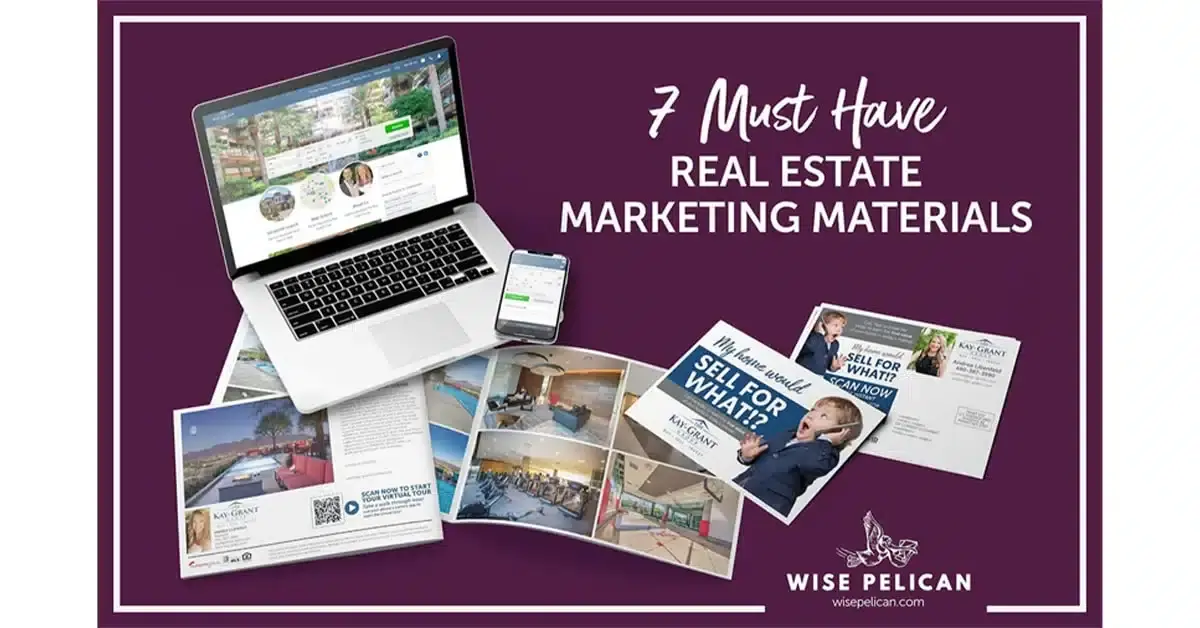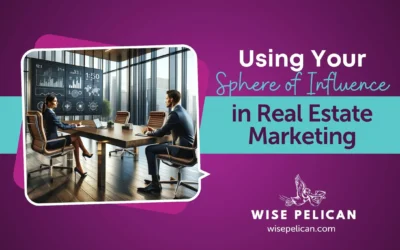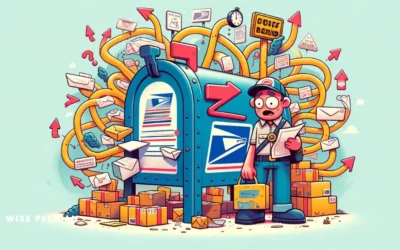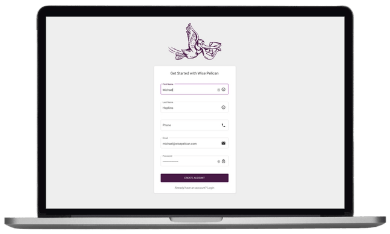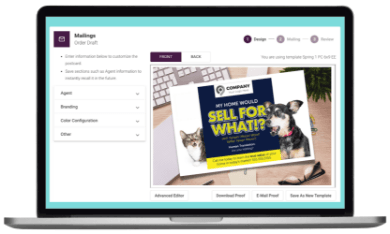The real estate industry is highly competitive, so finding a way to get noticed and to differentiate yourself is important. In fact, there are more than 1.5 million Realtors in the United States, and more are licensed each day.
Of course, many real estate agents throw in the towel during their first year or two in the business, and at least some of this attrition may be tied to the sheer level of competition in the industry.
The average real estate agent closes roughly six transactions each year. Competition for these clients is fierce. Having an effective real estate marketing campaign is essential for your success as a real estate agent.
Both print marketing materials, such as brochures and flyers, and digital marketing efforts, like social media campaigns and website advertisements, serve unique purposes and should be incorporated into your real estate agent marketing materials. By the end of this blog post, you will have a better understanding of the best marketing materials to help you grow your real estate business.
Real Estate Agent Marketing Materials: Print vs Digital Marketing:
Many new real estate agents focus exclusively on developing a marketing campaign centered around a few key avenues. For example, they may create a website and send out mailers periodically.
While this minimal effort will undoubtedly generate a response, the reality is that you may be missing out on an incredible opportunity to connect with more potential clients by limiting yourself in this way.
In fact, there is an extensive range of marketing materials that you can use to achieve specific goals. More than that, you will find that some methods specifically target sellers while others target buyers.
For example, farming and prospecting are marketing activities that target homeowners in a defined geographic area. Homeowners are interested in specific information, such as how much their home is worth and opportunities for upgrading or downsizing.
Door hangers, just listed postcards, just sold postcards, coming soon postcards, open house postcards, just sold letters, and other similar types of print marketing materials are effective ways to get in front of homeowners. More than that, these marketing materials can be used frequently to promote brand recognition and to stay in front of your target audience. A few sellers may contact you immediately when they receive your materials. Many others, however, will recall your name when they decide to sell in a year or two.
Reinforcing your farming efforts with regular touches is imperative.
On the other hand, digital marketing efforts typically target buyer leads. This is because buyers often peruse the internet to research listings well before they contact a real estate agent. These digital marketing efforts may be Google Ads, website landing pages and more.
While print marketing reinforces your brand and provides useful information to prospective leads, digital marketing, such as targeted Google Ads, encourages a direct and immediate connection at the time the buyer is interested in learning more. For example, a prospective buyer may click on your Google Ad while he or she is looking at listing photos. Because your ad pops up on the screen at a time when the buyer is ready to take his or her search to the next level, the buyer clicks the ad link to visit your website, showcasing the effectiveness of incorporating both print and digital strategies into your real estate agent marketing materials.
You can see that digital and print marketing methods target different types of clients. More than that, when you look at these methods in greater detail, you will see that each type of digital and print marketing targets those groups in unique ways.
When you limit your marketing efforts to one or a handful of methods, you are dramatically decreasing your visibility to prospective clients. Fewer leads mean fewer clients and lower profits.
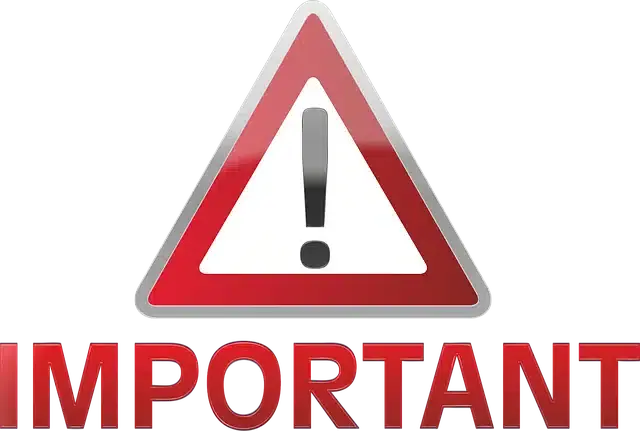
Why Are Real Estate Marketing Materials So Important?
Focusing your efforts exclusively on print and digital marketing is not the only ways to obtain leads. For example, networking within your social circle may produce a lead from time to time, as will referrals from your vendors and sphere of influence.
The major difference between using marketing channels and networking/referrals is scale. No matter how much effort you place on attending networking events, door-knocking, and obtaining referrals, there are still 24 hours in a day and 7 days in a week.
On the other hand, marketing provides the opportunity to automate and reach a larger audience with less effort. In addition to scale, they are essential for building brand recognition, communicating the services you offer, and demonstrating expertise.
Keep in mind that these marketing methods can be used at various stages throughout the sales process. For example, postcards and mailers may be used to keep your name and brand in front of your farm community. Business cards may be handed out when you meet a potential client in person. They may also be handed out in a listing presentation packet and included in envelope mailers.
Without taking advantage of all of these and other exciting opportunities available through the use of marketing materials, you are missing out on critical chances to build your business and to make valuable connections.
In order to maximize your earning potential, you need to develop an effective, multi-pronged marketing campaign that strategically takes advantage of a smart combination of avenues.
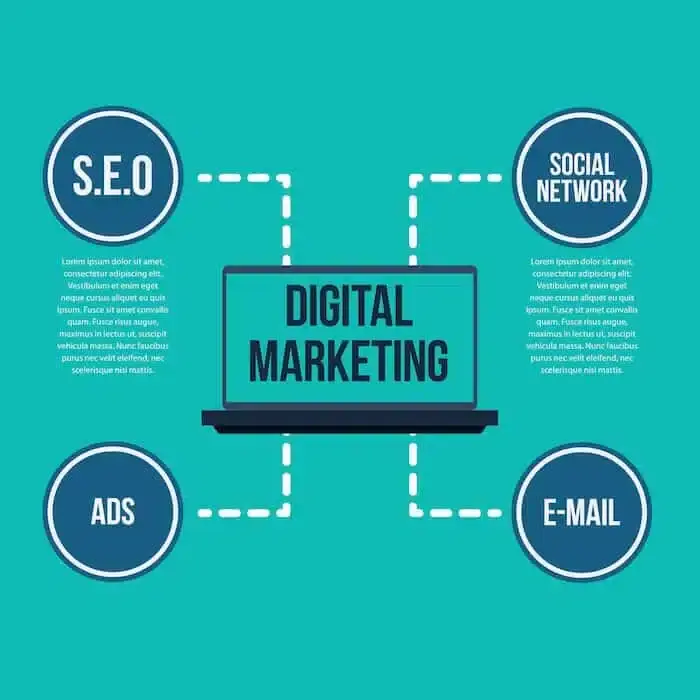
Best Digital Marketing Avenues for Real Estate
The digital avenues for real estate marketing continue to expand, so you should always keep your eyes open for new opportunities. However, there are some essential avenues that successful real estate agents consistently use. These should be considered as mainstays in your digital marketing efforts.
Professional Website: A Must in Real Estate Agent Marketing Materials
Your professional website is the foundation of your digital marketing efforts, and it reinforces your print marketing campaigns as well. Consider that most people today will research a real estate agent before deciding to reach out. What will potential leads find when they Google your name?
A website enables you to control the message so that you appear professional, knowledgeable and helpful. It defines your brand and showcases your professional experiences and accomplishments.
More than that, a website can actually generate leads for you. You may create landing pages for different marketing campaigns, and this enables you to collect leads and track responses.
If your website has access to your local MLS, you can also use your website to showcase current listings. This means that you may drive buyers to your website for more details about a specific property, and your website will act as a lead generation medium.
There are a few essentials that your professional website must have. These include:
Forced Registration with MLS IDX: IDX enables you to show MLS listings directly on your website without needing to duplicate posting efforts. In addition to simplifying your website management efforts, IDX ensures that your visitors can easily find the information on active listings that they are looking for.
Built for Speed and Functionality: Your website’s visitors will easily become frustrated by slow load speeds, a frustrating layout and other problematic design issues. These visitors may quickly leave your website, which results in a high Bounce Rate and lower performance.
Mobile-Friendly: Many people prefer to search for real estate listings on their smartphone. Your website should be formatted properly for fast loading times and easy viewing on all types of mobile devices.
Likewise, there are a few important things to avoid when you are designing your website. These include:
Large Files: As tempting as it may be to showcase a high-definition video on your website, large files slow down page load speeds. Large files can also take the form of PDF downloads and high-resolution images that have not been optimized.
An alternative to publishing these assets to your site is to embed a link for download or viewing on another platform. For example, a video link to your YouTube channel is ideal. Downloadable guides can be hosted on a 3rd-party landing page builder like Unbounce, which also allows you to capture names, emails, and phone numbers.
An Overly Complicated Structure: You want your visitors to spend ample time exploring all of the pages on your website rather than getting lost in them. Design your website with an intuitive structure and easy-to-find navigation buttons.

Social Media
Social media platforms popular with real estate agents, including Facebook and Instagram, give you a convenient way to build a following and to stay in touch with your digital community. Social media marketing is free to use, although you may want to invest in photo and video editing technologies.
Many real estate agents use social media platforms to market active listings, but these platforms can also be used to establish and build your brand, offer home buying and selling tips, deliver market stats and more.
Initially, your social media following may be very small. However, as you post quality content, your content will be shared with others.
Your social media connections will grow, and your reach will grow in the process. As beneficial as social media marketing is, there are a few things to keep in mind for the best results. Your social media marketing efforts should include:
Timely Posts: Social media posts make it easy to stay in front of your followers, but posting too frequently can become annoying. To avoid losing followers, strive to add no more than a few posts each week to your accounts.
Quality Images and Videos: Images and videos are essential for social media marketing. To optimize their full power and to ensure that you maintain a professional online image, only post high-quality images and videos that have been carefully enhanced or edited as needed.
Value-Added Content: Each social media post should add value to your followers Consider adding content like links to new listings, links to relevant real estate news stories, public interest posts to convey your expertise in the community and more.
There are also a few things to avoid with social media marketing. These include:
Posting Too Frequently: When you post too frequently, there is a strong chance that some of your users will unfollow or unfriend you. This is particularly true when the content being posted lacks substance. Consider creating a publishing calendar to avoid posting too frequently.
Failing to Interact with Contacts: When users and followers take the time to ask a question or leave a comment, they can be turned off if they fail to receive a response. Take advantage of the two-way communication offered by social media platforms to interact directly with those who respond to your posts.
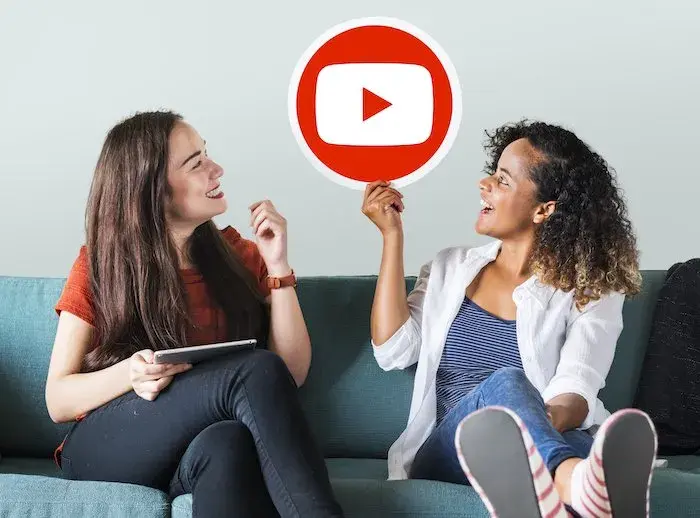
YouTube Marketing
YouTube is the second largest search engine behind Google, so you are missing out on a great opportunity to elevate your online visibility if you are not using YouTube for marketing purposes. Links to YouTube videos can be posted on your website, in guest blog posts, on social media platforms and more.
This gives you the direct opportunity to take each of these marketing opportunities to a new level by adding videos to the mix. You can even use SEO with your YouTube videos to increase search engine rankings and promote visibility further.
There is an extensive range of content ideas for real estate YouTube videos. For example, you may post a link to an introductory video on your website’s homepage and on your social media platforms’ profile pages.
You can also post property listing tours, educational videos with tips for buyers and sellers, insights on how market trends may impact buyers and sellers and more. YouTube is a powerful marketing resource, and you can optimize its benefits in these ways:
Creating a Customized YouTube Channel: A YouTube channel enables you to group all of your videos together under one URL. This is essential for promoting your video content, and it enables your followers to subscribe to your channel and to receive notifications when new videos are available.
Posting Quality Video Footage: Creating high-quality videos is essential for portraying yourself as a true professional. In addition, quality video footage gives your audience a better viewing experience and encourages them to watch your videos in their entirety.
Running YouTube Ads: From in-stream video ads and bumper ads to discovery ads and more, there are many options within the YouTube platform for promoting your channel. You can even customize where your ads will run so that you can target your local audience.
There are also a few things that should be avoided when using YouTube for marketing purposes. These include:
Videos That Are Too Short or Too Long: Your video should be concise and straightforward without unnecessarily rambling. If your video is more than 15 minutes long, it makes sense to break it down into multiple parts.
Not Branding Your Channel: YouTube gives you plenty of opportunities to customize and brand your channel, including naming the channel, choosing a profile picture, uploading banner art and more. These are convenient ways to brand your YouTube presence, so select your design elements with care.
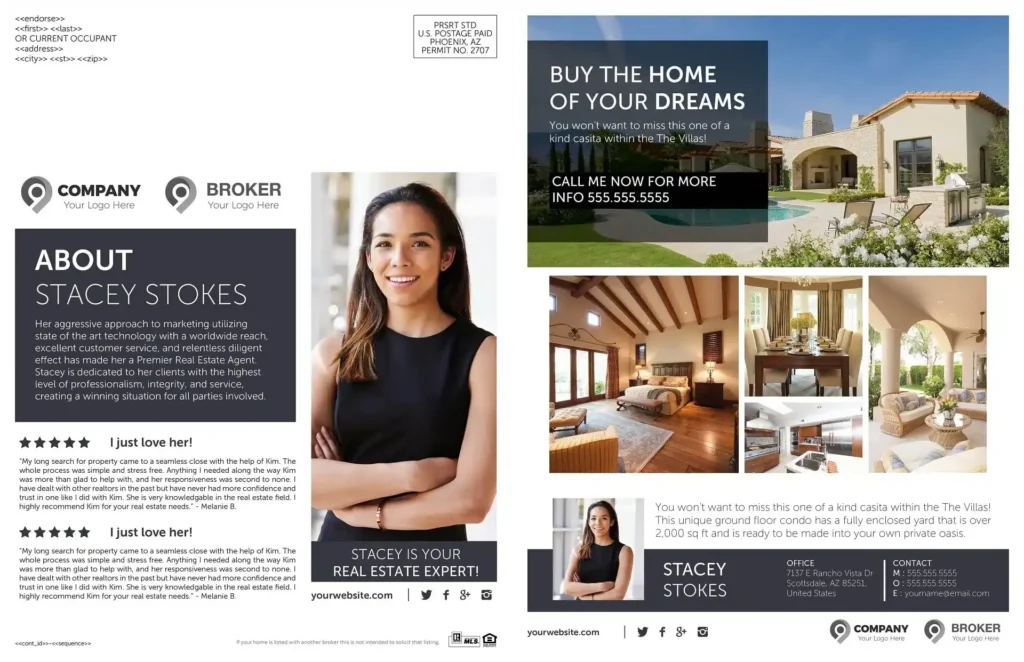
Print Marketing Materials for Real Estate
There are many types of print marketing materials that real estate agents can and should use on a regular basis. These materials find their way directly into the hands of your target audience. They immediately offer branding benefits and convey essential information, and they can also be saved for later use. Each of these types of print marketing materials plays a different and essential role and should be incorporated into your marketing efforts to some degree.
Business Cards
When you meet someone face-to-face, you want that person to remember your name. You also want to make it easy for that person to contact you and even to research your professional background. A business card may initially seem like an outdated marketing item, but it continues to play a crucial role in a real estate agent’s success.
Your success as a real estate agent is rooted in your ability to make many personal connections. By handing out your relevant details on a business card, you are essentially taking a crucial step to move that initial connection to the next level. Essentially, a business card is an invitation for the recipient to get in touch with you.
Business cards can be handed out in a variety of situations. For example, you may make a connection at a friend’s party or while standing in line at the supermarket. You may meet potential clients while hosting an open house or while canvassing a neighborhood with a door-to-door knocking campaign.
You can also add a business card to mailed letters and other enclosed marketing materials. To optimize the power of your business cards, you should keep these important details in mind:
Professional Branding: Your business card will make a statement about you long after your initial conversation ends. It should be appropriately branded to convey what your brand stands for and what your professional values are.
Social Media and Website Info: In between the time you hand out your card and the recipient contacts you, he or she will likely research you online and on social media platforms. Make it easy for potential clients to find the information you want them to see by listing links to your website and social media pages.
Basic Information on Your Services: A business card may be tossed aside for weeks or longer before the recipient comes back to it. Provide a short list of your primary services for easy reference.
What should you avoid when using business cards for marketing purposes?
An Overly Busy Design: A business card is meant to be scanned rather than read in detail. Avoid using an overly busy, cluttered design, and choose a straightforward layout that makes it easy to find relevant information at a glance.
Failing to Hand Them Out: Business cards are a great resource when they are handed out. Always keep a healthy supply in your wallet or handbag to hand out at a moment’s notice.
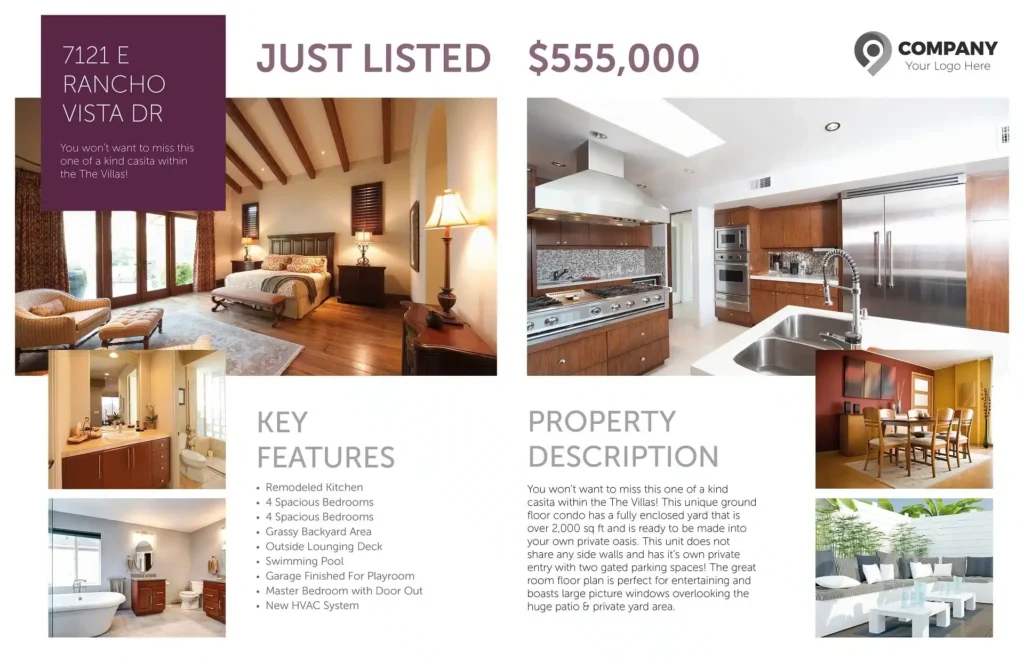
Brochures
Whether you are going door-to-door in your farm community or you are sending out a mailer, real estate brochures provide you with a convenient, concise way to convey critical information.
For example, a brochure may have a list of recently sold homes in the area or other relevant market data.
Brochures are larger than postcards, so they may hold far more information, but they also require more effort to deliver to the recipient. With this in mind, they may be used in conjunction with a postcard mailer campaign rather than as an alternative.
Brochures may be saved for future reference and even passed from neighbor to neighbor within a community. They serve an important purpose at the moment they are received, and they can continue to benefit the real estate agent and the recipient long afterward. What should you focus on when using brochures for real estate marketing purposes?
Incorporate Branding: All of your print marketing materials should be branded, and this includes brochures. By offering quality information on a branded flyer, you can portray yourself as being helpful, knowledgeable and a local real estate expert.
Include Value-Added Content: The best real estate brochures are those that recipients want to hang onto. These are pieces that offer valuable content that may be referred to again in the future.
Valuable content examples include recent sales in the community (ideal for listing presentations) and a valuation and potential equity of their home.
Add a Call-to-Action: While it is important for your recipients to see value in your brochures, you understandably want them to take a specific action. Ensure that you invite the recipients to call you, request more information online, watch a video or take other specific steps.
What should you avoid when marketing with brochures?
A Poor Layout: Brochures can and should convey important details that are relevant to the recipients, but that information is useless if the recipients cannot make heads or tails of it. Ensure that the layout is easy to follow and that the information presented is easy to digest.
High-Frequency Delivery: Whether you hand out your brochures or you mail them, you do not want them to be viewed as junk. Even quality content can be viewed as spam when it arrives too frequently, so follow a production schedule to ensure the timely delivery or dispatch of your marketing material.
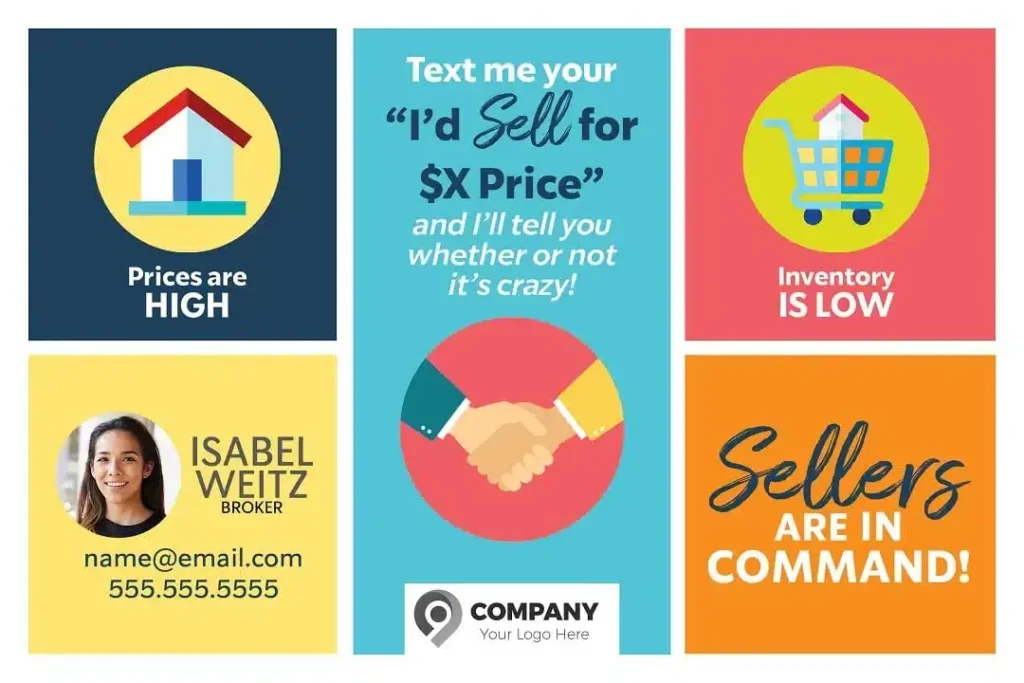
Postcards
In the digital age that we live in, sending out postcards can seem antiquated. However, postcards continue to serve a crucial role in successful real estate agents’ marketing efforts. Postcards are easy to create and affordable to mail. More than that, because there is no envelope involved, the recipient can view the message immediately.
Often, postcards are used for real estate farming because of these and other benefits. Through farming, you can establish and build your brand, position yourself as a local market expert and stay in touch with your target audience.
In fact, postcards are so beneficial that they may become a hallmark of your overall print marketing campaigns. Before you send out your next batch of real estate marketing postcards, however, there are a few important things to keep in mind. What should you include when marketing with postcards?
Common real estate postcards include coming soon postcards, just listed postcards, just sold postcards, open house postcards, and under contract postcards.
Tailored Content: Postcards are sent to specific recipients, and this gives you the ability to refine the information on them to suit those specific recipients. For example, tailored content may include a Automated Seller Valuation QR Code or an announcement of recent closings within the subdivision or neighborhood.
A Strong Call-to-Action: Do you want the recipient to attend an open house that you are hosting, to watch a video you just created or to contact you for a CMA on their home? Effective postcards clearly detail the action that you want the recipient to take.
A Proven Design: You do not have to recreate the wheel each time you prepare a batch of postcards. There are many effective designs available that you can customize with your message to save time.
What should you steer clear of when marketing with postcards?
Sending Postcards Infrequently: Consistency is everything when it comes to real estate postcards. Monthly mailings should be the absolute minimum, and the key is to send your postcards on the same day every month.
Listing Presentation Packet
A listing presentation is your opportunity to convert a lead into a client, so your marketing efforts with that individual are not yet over. You need to convey essential information about your professional services, how you intend to market the listing, your local market expertise and more.
All of the information must be presented in an organized, professional manner, so it makes sense to include the materials in a branded folder.
What will you include in this branded folder? Many real estate agents market listings and open houses locally using postcards, so a sample postcard used for another listing is a good idea. Brochures for yard sign boxes, flyers to place inside the house for showings and other materials may also be used.
In addition to showcasing examples of the marketing materials that you plan to use for the listing, you may want to highlight stats showing your success as a real estate agent, provide market stats and include other relevant information.
There are a few must-haves for every listing presentation packet. These include:
A Comparative Market Analysis: The hallmark of your listing presentation is a comparative market analysis. Ensure that the CMA takes the top position in the folder and is well-designed.
Marketing Examples: While the CMA supports the recommended list price for the home, the marketing materials in the listing presentation packet show how you plan to present the home to prospective buyers. Including quality materials that are representative of your marketing plan for the listing.
A Business Card: A homeowner may not decide to act for several weeks or longer after the presentation. A business card should be included in every listing presentation packet so that the homeowner can conveniently get back in touch with you.
There are also a few things to avoid in your listing presentation packets. These include:
Low-Grade or Unprofessional Materials: The purpose of providing marketing materials in a listing presentation is to wow the homeowner with high-quality, professional content. When the materials are unprofessional, however, including these materials in your listing presentation packet may unfortunately backfire.
Conclusion
You can see that both digital marketing efforts and print marketing materials, such as flyers and brochures, play crucial and unique roles in your real estate agent marketing materials. More than that, each unique digital and print marketing opportunity has specialized benefits that you want to take advantage of.
With this in mind, now is the perfect time to review your marketing efforts and make strategic improvements.
